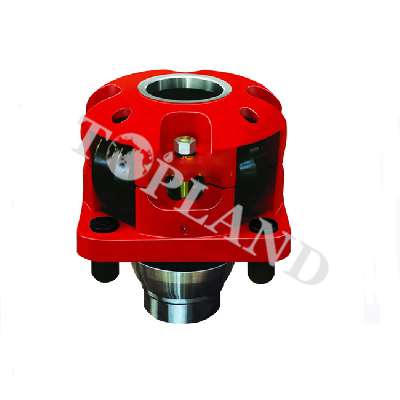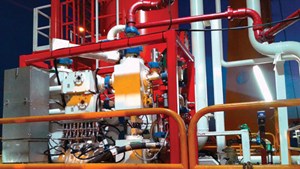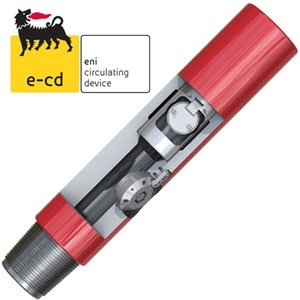BREAKTHROUGH TECHNOLOGY: CONTINUOUS CIRCULATION MEETS TODAY'S DRILLING CHALLENGES
The oil and gas industry is always seeking innovative ways to improve drilling efficiency via technology breakthroughs, the main driver being to minimize nonproductive time (NPT) when carrying out downhole operations—onshore, offshore, or in remote locations. The time that it takes to drill a well depends on multiple factors, all of which can significantly impact rig cost and work schedule estimates.
Common challenges that often require time-consuming and costly mitigation efforts include: bottomhole pressure (BHP), solids and cuttings, stuck pipe, ballooning effects, temperature of bottomhole assembly (BHA) components, and formation integrity issues. This article introduces Halliburton’s enhanced continuous circulation technology, which represents a step-change in managed pressure drilling (MPD), and how it outperformed previous methods to connect drill pipe from a floating vessel offshore West Africa.
ABOUT CONTINUOUS CIRCULATION TECHNOLOGY
In use since 2006, Eni designed, patented, and developed the continuous circulation subcomponent technology, in which Halliburton received the license from Eni to further develop and utilize the technology to meet today’s economic drilling challenges. Essentially, by maintaining constant circulation of drilling fluid, operators can keep their rig pumps on while adding and removing drill pipe. This unique technology solves many of the potential problems mentioned above; in particular, it helps maintain flow through continuous hole cleaning and solids transport.
Since there is no need to stop flow—for standard drilling or tripping connections, to run a liner, or when performing cementing and/or completions operations—the frictional pressure and BHP values remain unaffected. This differs from conventional connection methods, or even MPD connections of the past, which need to somehow compensate for lower frictional pressure. It also allows the operator to mitigate kick and/or loss conditions, by maintaining a constant equivalent circulating density (ECD) and BHP.
The overall drilling process is optimized, as the continuous circulation system is compatible with downhole tools operating simultaneously on the rig via an interactive interface. It is, therefore, meant to complement, not block, the use of other apparatus needed to accomplish the job at hand, whether it be measurement-while-drilling/logging-while drilling (MWD/LWD), wireline/slickline intervention, etc.
System components. The system comprises two main components: a diversion manifold and a continuous circulation subcomponent. While the subcomponent (Fig. 2) is integrated with the drill pipe, the manifold is connected to the rig standpipe, Fig. 1. By installing the manifold during regular rig downtime, no extra time is added to the drilling.
Operators can leverage this to perform these drill pipe connection steps:
● Bleed-off of the top drive
● Divert flow to the side port of the sub during connection
● Re-establish flow
● Bleed-off flowline connected to side port once connection is done.
● In addition to drilling or tripping sections of wells with tight pressure margins, continuous circulation technology is useful to:
● Maintain formation integrity and borehole stability by reducing ballooning effects and pressure cycling on the well by removing pumps-on/pumps-off condition
● Extend BHA life by maintaining the dynamic well temperature
● Reduce transitional errors during drill pipe connection by lessening the need for human intervention
● Prevent mud rheology or composition changes by maintaining a constant flow
● Reduce connection gas and any other negative side effects by stopping and restarting flow
● Improve rate of penetration (ROP) through continuous hole cleaning.
CASE STUDY: OFFSHORE WEST AFRICA
Due to its hole cleaning benefits, continuous circulation technology was used extensively during a long-term drilling campaign for a development well offshore West Africa, with water depths ranging from 600 m to 1,000 m. This solution helped improve ROP through continuous hole cleaning, which enabled one stand to be drilled per hour, or faster. Constant circulation during the drill pipe connections significantly enhanced operational efficiency, by reducing the time needed for hole cleaning after each stand was drilled down—in both oil-based mud (OBM) and water-based mud (WBM) conditions. This approach also helped improve cuttings transport efficiency, as well as mitigate stuck pipe incidents.
During this campaign (from 2015 to 2019, with stops and starts), more than 1,230 successful, continuous, circulation drill pipe connections were performed over about 535 operating days, during both drilling and tripping. The program involved predominantly oil wells (some horizontal, others deviated) and several vertical gas wells. Because of the system’s ability to increase ROP, thanks to continuous hole cleaning, approximately five drilling days were saved per well—equal to an 85-drilling-day reduction, compared to earlier drilling. This resulted in considerable cost-savings to the operator and accelerated the time to obtain first production.
Halliburton provided training on the continuous circulation system to operators, contractors, and other rig personnel before implementation. It was critical that everyone on the rig understood the process, as it differs considerably from a conventional drill pipe connection. Given the program’s length, the rig crew was able to gain experience and familiarity with the technology, significantly benefiting day-to-day operations and system efficiency. Table 1 gives an overview of the operational data.




 Upload RFQ
Upload RFQ







 Twitter
Twitter Linkedin
Linkedin Facebook
Facebook YouTube
YouTube Sales@toplandoil.com
Sales@toplandoil.com +86 21-50890868
+86 21-50890868 Head Office: 8-1011,Lane 5600, Chuansha Road, Pudong, Shanghai, China
Head Office: 8-1011,Lane 5600, Chuansha Road, Pudong, Shanghai, China 